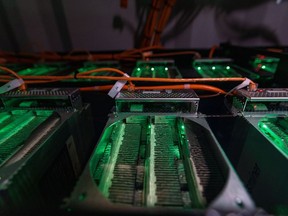Ethereum Overhaul Risks Creating a New Class of Crypto Kingpins
(Bloomberg) — The much-anticipated upgrade of Ethereum will create new participants called builders in the blockchain ecosystem, a move that risks altering the power structure of what is arguably the most commercially important cryptocurrency network.

Article content
(Bloomberg) — The much-anticipated upgrade of Ethereum will create new participants called builders in the blockchain ecosystem, a move that risks altering the power structure of what is arguably the most commercially important cryptocurrency network.
Advertisement 2
Article content
Under the current system, networks of computers known as miners pluck transactions out of a special data pool, and arrange them into blocks that are added to the blockchain. The miners are being eliminated as part of a plan to reduce energy consumption. After the planned September upgrade known as the Merge, the builders will gather transactions into blocks, which they will then send to the validators. The validators will sign off on the order of the blocks that will form the upgraded blockchain.
This seemingly geeky change, part of a portion of the software upgrade that is called MEV-Boost, could potentially make Ethereum more centralized, at least initially. While there are already more than 416,000 validators lined up to order transactions, there are only a handful of participants committed to serving as builders. The largest is Flashbots, which makes open-source software used by trading bots.
Advertisement 3
Article content
Flashbots is already the dominant way for miners to collect fees from traders by letting their transactions front-run and otherwise step around others. Other participants are considering becoming builders because of concern about Flashbots or similar entities having too much control.
“It kills decentralization,” said Uri Klarman, chief executive officer of BloXroute Labs, which has a network of servers that let traders send transactions to miners faster. About 40% of all the trading volume from decentralized finance apps, which let people trade, loan and borrow coins, is routed through the network, he said.
One risk is that a powerful digital wallet like MetaMask, which gives users the ability to buy, sell and receive cryptocurrency, could become a “king maker,” Klarman said. MetaMask is the most popular non-custodial wallet, with 30 million users.
Advertisement 4
Article content
A wallet service could favor one builder over all others and even decide to act as a builder, thus controlling the flow of transactions, Klarman said.
MetaMask is owned by the New York-based ConsenSys, which was founded by Ethereum co-founder Joseph Lubin. The software firm dismisses the concern.
“We will never send all of MetaMask’s transactions to one specific builder or provider,” said Taylor Monahan, global product lead at MetaMask. “MetaMask’s value is derived from being a gateway to an exciting, vibrant, diverse and fair ecosystem. For that reason, MetaMask will always strive to make decisions that promote a healthy and decentralized Ethereum.”
The builder-validator role split was initially conceived as a way to increase Ethereum’s decentralization, and to take the power away from validators.
Advertisement 5
Article content
Still, having too few builders on the upgraded Ethereum chain raises potential issues. They could censor transactions from being included into blocks. Earlier this month, Flashbots blacklisted wallets associated with Tornado Cash, after the mixer protocol was sanctioned by the US Treasury Department.
If there are very few builders, they can also command higher fees, with validators earning less. That could, in turn, lead to fewer validators choosing to get involved in supporting the network. To date, miners have earned about $240 million on the transaction-reorganization service, called MEV, according to Flashbots. The fees are expected to be a significant contributor to validators’ revenue as well.
Advertisement 6
Article content
Builders can also capitalize on their users’ order flow. If a builder knows that a lot of users are placing orders for a particular token, they could buy a long position in it, for example.
It’s like “Robinhood, making money off order flow,” said Nathan Worsley, referencing the commission-free trading firm. Worsley and his partners, who make money off of transaction reorganizing liquidations and various complex trades, are considering becoming a builder, he said.
Worsley isn’t alone in considering a change in focus because of the potential centralization risks and power shift.
“We’ll monitor the situation. If it gets closer to a centralized builder world, we’ll take action,” said Jonas Pfannschmidt at Blockdaemon, which runs validator nodes for clients.
Advertisement
For all the latest Business News Click Here
For the latest news and updates, follow us on Google News.

